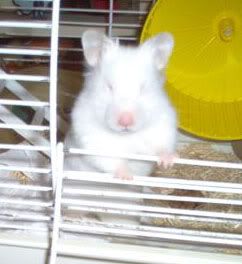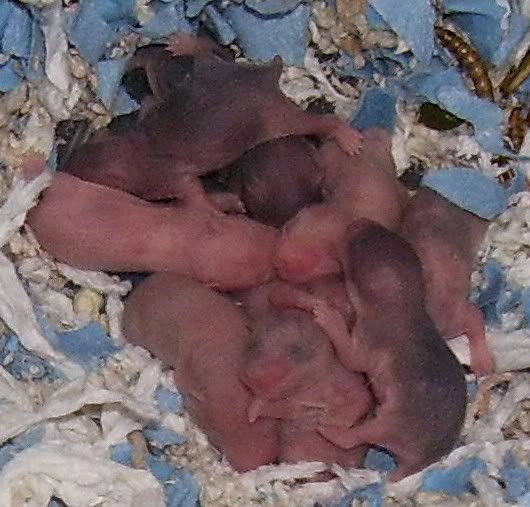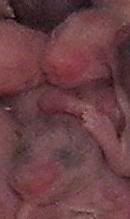|
|
| ||||||||||||||||||||||||||||||||||||||
|
Syrians require supervision while breeding since they are solitary. You can not leave them together and let nature take it's course or you will end up with a fight and possibly dead Syrians.
First let me say that breeding is a big responsibility. You need to make sure your area has a good market for pocket pets so that you can find homes for all of them BEFORE making the decision to breed. Since Syrians are solitary every pup will require separate housing by 6 weeks of age. If you think there is money to be made in breeding you're wrong. The cost of housing, food and bedding is much more then what any pet store will give you for pups, if they give you anything. Private sales are few and far between. Even if you could sell all of your pups from all of your litters via private sales it would not meet the costs of raising a litter.
![]() Please read To
Breed or Not to Breed first, then visit the Rescue pages before deciding to breed.
Please read To
Breed or Not to Breed first, then visit the Rescue pages before deciding to breed.![]()
Unfortunately for you, your pet may be a mother soon and you didn't know it. Most pet stores keep the litter together - boys and girls - as long as they can to save space. Girls can get pregnant as young as 3-4 weeks and boys can impregnate as young as 4-5 weeks. This usually requires an experienced partner but not always.
There are certain genes that should not be bred together.

![]() Anophthalmic White - This happens when you breed two Roan (or White Belly) hamsters together. Since it shows as a White Belly
in all colors except the Creams, the White Patterns (except banded with dom spot) shouldn't be mixed with each other or with Dark Eared White.
This is why most UK groups advise against breeding any white patterns together - even two banded hamsters or dom spots.
Anophthalmic White - This happens when you breed two Roan (or White Belly) hamsters together. Since it shows as a White Belly
in all colors except the Creams, the White Patterns (except banded with dom spot) shouldn't be mixed with each other or with Dark Eared White.
This is why most UK groups advise against breeding any white patterns together - even two banded hamsters or dom spots.
|
![]() Banded Dom Spot Cinnamon - This is a lethal combination. During the
development of the fetus, the part of the cells that produce color (melanin) also affect the development of the intestines. The hamster pup I have
pictured died soon afterwards.
Banded Dom Spot Cinnamon - This is a lethal combination. During the
development of the fetus, the part of the cells that produce color (melanin) also affect the development of the intestines. The hamster pup I have
pictured died soon afterwards.
Syrians become sexually mature from 3-6 weeks. Syrian girls go into heat every 3-5 days. When they are receptive to mating, they will go into a breeding stance called 'standing' when anything touches their back - even their water bottle. They will usually give off a musky odor and have a creamy yellowish discharge.
IMPORTANT!! A Syrian hamster's pelvic bones fuse around 6 months of age. If the girl has not had a litter to spread the pelvic bones before then, her hips will fuse in the narrower position. Breeding her at this point will kill her litter and probably kill her.
If you decide to breed, now is the time to introduce the boy. This is best done in a neutral territory or the boy's area and as late in the evening as you can - they are nocturnal animals. You will want to have easy and quick access in case one or both are not interested. The bath tub is a good place as long as the hamsters have traction under their feet. Keep a big plastic cup (or two) handy to separate the pair if there are any squabbles. This will keep your hand away from very sharp teeth. The smell of the girl will attract the boy and he will usually start by smelling the scent glands on her hips.
When the boy is ready, he will mount the girl several times. Someone had determined that the 11th mating is the most successful. Don't ask me how they figured that out. I'm not sure I want to know. Mating will last from 10 - 45 minutes. You MUST watch them the entire time. If the girl isn't ready and willing, she'll attack the boy. She may also turn on the boy when she has had enough of mating. Or the boy may get too rough in his mating attempts. The more they mate the larger the litter is likely to be.
Syrian gestation is 16 to 18 days. As the pregnancy progresses, the female will develop a "pear" shape to her body. If you can see pups moving in the female's stomach the birth is only days away. You should do a last major cage cleaning a couple of days before you expect the litter. This will give the expectant mother a chance to build a suitable nest and feel secure in her home. Besides her normal bedding material, give her plenty of cheap, white, unscented toilet paper to line her nest. Make sure the expectant mom has plenty of water available. Do not restrict food intake at this time. Supplement her food with fresh, raw vegetables, cooked chicken and cooked egg (no frying, spices or seasonings). This is also a good time to pull out any pups that may still be with the folks.
Rodent females will go into heat the day or evening they give birth. This is called post partum estrus. She'll breed if a male is present. Being solitary there should not be a mature male present.
Syrians can have up to 24 pups but usually end up with something in the teens. Delivery will normally take place during the night. She may give birth around the tank and leave the pups there as she delivers the next one. Don't panic. Mom will gather them up afterwards into the nest.
If a mom is new or stressed she may attack the pups. Syrian's are very protective of their pups and stress easily if the nest is poked at. New ownership is also stressful.
Having given these dire warnings most litters manage just fine especially without human intervention. The best thing you can do is leave mom to do what nature tells her to do. Most animals know instinctively how to care for their babies. The worst thing new breeders can do is interfere with the litter too soon. The mother will not sit constantly on the nest. She will take breaks to take care of bodily functions. Most homes are kept at a temperature that the pups do not need constant warming from mom. And if otherwise healthy they don't need to constantly nurse. Sometimes nursing pups don't let go when mom leaves her nest. Again, let mom take care of things. She'll hear them and gather them back up into the nest. The safest action is to not get involved too quickly with a litter. Some pups may not survive because they were too small or something else is wrong. Mom will usually clean up the nest area by eating any dead pups. This may sound disgusting but it actually helps give the mom some nutrition back that she looses while having a litter. Keeping dead animals out of the nest is a survival instinct to keep predators away, too.
Newborn pups are generally called pinkies. They are born naked, deaf and blind. At this stage they react to heat and touch. They roll onto their backs while mom huddles over them to nurse. Later as they get bigger and grow fur, mom will lay on her side or back to nurse. You can tell from birth what color their eyes will be by looking at their eyelids. If the eyelids are pink then their eyes will be red, if the eyelids are dark then they'll have black eyes. You can even see some pigment and patterning at birth. The pictures below are of a Syrian litter that's two days old. You can already see skin pigment and the close-up on the right shows a black eyed pup (bottom) and a red eyed pup (top 2).
 |
 |
 You
should continue to supplement mom's food and you may add KMR® (Kitten
Milk Replacement). Use a shallow dish that pups can easily climb out to avoid drowning. This is a good transition food for weanlings and mom
can use the extra while nursing.
You
should continue to supplement mom's food and you may add KMR® (Kitten
Milk Replacement). Use a shallow dish that pups can easily climb out to avoid drowning. This is a good transition food for weanlings and mom
can use the extra while nursing.
Moms may be very protective of their babies and territory (the tank or cage). It's best to leave everybody alone until the pups are roaming on their own AND mom stops trying to herd them back into the nest, usually 14 days. You can sometimes entice the mom out of her nest with a healthy bit of food and peak into the nest. Always wash your hands then rub some of the bedding in your hands before handling pups. Any strange smell on them could upset the parents. Cup your hands over them and hold them near the ground or the bottom of the tank so that if they jump they don't have too far to fall.
At 3 - 4 weeks the pups should be weaned from the mom. At 6 weeks the pups need to be separated into their own solo tanks until you can rehome them.
|
||||||||||||||
| ||||||||||||||||||||||||||||||||||||||||